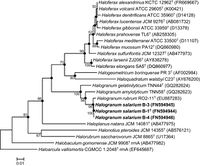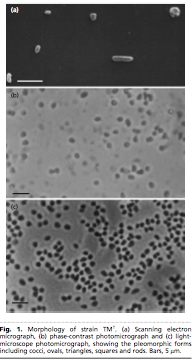Haloferax alexandrinus
Haloferax alexandrinus
Classification
Domain (Archaea);Phylum (Euryachaeota); Class (Halobacteria); Order (Halobacteriales); family (Halobacteriaceae). Genus; Haloferax Species; Haloferax alexandrinus
Higher order taxa
Kingdom: Archaea Phylum: Euryarchaeota Class: Halobacteria Order: Halobacteriales Family: Halobacteriaceae Genus: Haloferax Species: Haloferax alexandrinus
Description and significance
Haloferax alexandrinus are characterized as an extremely halophilic (live and grow in a saline environment). Haloferax alexandrinus are red-colored cells, the color mainly being due to the presence of C50 carotenoids which its organic pigments that found in photosynthetic organisms.[1]. They are very pleomorphic which means they have different shapes, non-motile and strictly aerobic and need to live in environment of at least 10 g NaCl-1 for their growth. Also cells can grow aerobically in salty medium with ammonium chloride (halophilic archaea).[1]. Sine they live in a high concentration of NaCl medium, they don't need for sterilization procedure to prevent contamination.
Genome structure
A PCR assay was preformed to identify the species of Haloferax as a result of the fundamental amplification of 16S rDNA.[2] As a reason of identifying the species and for knowing the hybridization probe, which is a fragment of DNA or RNA of variable length (usually 100-1000 bases long) which is used in DNA or RNA samples to detect the presence of nucleotide sequences that are complementary to the sequence in the probe, it was possible to select the two variable regions of the 16S rDNA as genus-specific primers, which that led to know that the strains of Haloferax spp. were positive.[2] However, species belonging to the most closely related genera were negative. In addition, the mass bloom of halophilic Archaea that develops in the El-Mallahet saltern of Alexandria City was positive using the same approach. This assay rapid method is for identifying Haloferax ssp. without the requirement of pure cultures of microorganisms in hyper saline environments.[1]
Cell and colony structure
Haloferax alexandrinus are rod-shaped cells with dimensions that varied from 1.1 to 1.5 μm, 1.6-2.0 μm in size.[1] They are characterized by the reddish color which is as a result of growing in saline environment. the concentration of the total dissolved salts increases to saturation at pH 7.2 which is might be unusual for other organisms to live under these extreme conditions of the saltern. The saltern surface is characterized by a reddish purple color corresponding to the growth of red halophilic members of the Achaea; other organisms cannot survive there. [1] It’s unique within the genus Haloferax in producing canthaxanthin. Carotenoids are important because these pigments including cathaxanthin have been shown to possess physiological functions in the prevention of cancer and heart disease by quenching free radicals or single oxygen enhancing in vitro antibody production, as well as providing visual system with precurosors of vitamin A.[1] Thin layer chromatography (TLC), spectrophotometry, (EI-MS), nuclear magnetic resonance spectrometry (13C-NMR), and high performance liquid chromatography were used to investigate the core lipids of the Haloferax alexandrinus strain TMT. It was detected the major phospholipids which were found to be phosphatidylglycerophosphate-methyl ester (PGP-Me) and phosphatidylglycerol (PG). The strain contained two glycolipids, unsulfated diglycosyl diether, and sulfated diglycosyl diether. Analysis of the non polar lipids showed the presence of 3-hydroxyechinenone, beta-carotene, gamma-carotene, lycopene, cis-astaxanthin, trisanhydrobacterioruberin, bacterioruberin isomer, and canthaxanthin. Haloferax alexandrinus strain, the polar lipids profile, was similar to those of the other species of the genus Haloferax, however, the non polar lipids (carotenoids) were clearly noticeable to be different.[1] The colonies of the Strain TMT on the standard growth ager medium were circular, smooth and red as a result of the salt concentration at 250 g NaCl I-1 which will change to red as the concentration reduced and the size increases after incubation gradually.[1]
Metabolism
For some extremely halophilic archaea, that classified under one orderHalobacteriales and one familyHalobateriaceae which are chemo-organitrophic organisms, get the energy from light.The carbon sources as sugar, acetate, and succinate are used and take place in their growth. These micro-organisms are able to utilize single carbon sources such as sugars, acetate or succinate for growth.[1]
Ecology
It can live inside a living organisms as their host. It is very pleomorphic which means have different shapes, non-motile and strictly aerobic and requires at least 10 g NaCl l-1 which its important for growth of the micro-organism stains gram negative. Also cells can grow aerobically in salty medium with ammonium chloride (halophilic archea).[1]
References
[1], D. "Lipids of Haloferax Alexandrinus Strain TMT: An Extremely Halophilic Canthaxanthin-producing Archaeon." Journal of Bioscience and Bioengineering 93.1 (2002): 37-43. Print.
[2]., Asker, and Ohta Y. "Production of Canthaxanthin by Haloferax Alexandrinus under Non-aseptic Conditions and a Simple, Rapid Method for Its Extraction." Applied Microbiology and Biotechnology 58.6 (2002): 743-50. Print.
Pages edited by Safa Al Qayyar students of Dr. Lisa R. Moore, University of Southern Maine.http://www.usm.maine.edu/bio


